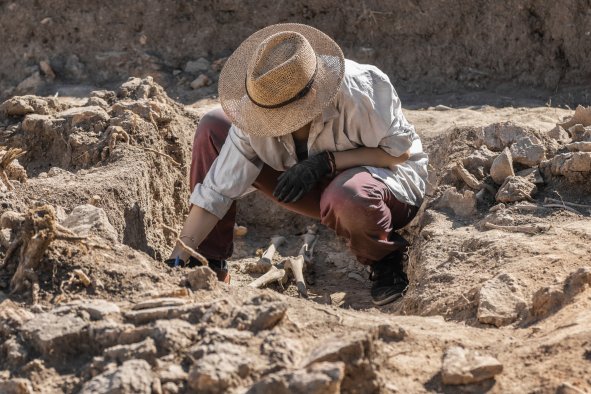Archaeologists have announced the discovery of a remarkable wooden artifact that has been preserved for about 3,500 years since the Bronze Age.
The prehistoric object, a kind of wooden spade, was found during excavations conducted in the Arne Moors—a significant area of wetlands and heathland located in the county of Dorset, southwest England.
The object is thought to be one of the oldest and most complete prehistoric wooden tools ever found in Britain. It is extremely rare for organic material, such as wood, to survive for so long, requiring very particular conditions.
"The spade is a really rare survival for the Bronze Age period," Ed Treasure, an environmental archaeologist with British firm Wessex Archaeology, which conducted the excavations, told Newsweek.
"It is likely that similar tools were more widely used in this period, yet wooden objects such as this can only survive in specific burial conditions. This is what makes the spade such an exceptional discovery. It provides with a glimpse into human activity within the wetland landscape in the Moors at Arne."
The preservation of the wooden spade can be explained by the condition of the ground at the site where it was found.
"The spade has preserved due to the waterlogged conditions on the site," Treasure said. "This is where the ground remains permanently saturated with water, thereby excluding oxygen, and inhibiting processes of decay."
Analysis of the spade has revealed that it is made of oak and hewn from one solid piece of wood. It would likely have required many hours of manual labor to produce, making it a precious tool for the creator. The spade could easily have been reused or refashioned for other purposes if broken or damaged, making its survival even more remarkable.
Radiocarbon dating of the object has indicated that it is about 3,500-3,400 years old, placing it firmly in the Middle Bronze Age. During this period in Britain, people had settled into rural agricultural lifestyles, creating farmsteads, villages and extensive field systems. But there is little evidence to suggest that there was a permanent domestic settlement at the site where the spade was found. Instead, experts believe that people visited the site seasonally.
In the Middle Bronze Age, the Arne Moors would have been prone to flooding in the winter but would likely dry out over the summer. This phenomenon provided the opportunity for prehistoric Britons to make use of the rich natural resources of the challenging landscape.
"We believe that this landscape was seasonally occupied and repeatedly re-visited, perhaps over a period of centuries," Treasure said. "Wetlands such as these offered a wide range of resources to people in the past; they provided areas to hunt wild animals or catch fish, reeds could be harvested for thatching, sedges and peat for fuel, rushes for flooring materials, wood for construction and areas for livestock grazing. Ultimately, the spade is related to the seasonal use of this landscape."
Only one other wooden tool like this has been found in Britain. The artifact in question—a long, leaf-shaped shovel-like item that possibly also dates to the Bronze Age—was recovered in 1875 by antiquarians excavating an ancient mine in Cheshire, a county in northwest England.
Ongoing research is aiming to understand what role these kinds of wooden tools played in prehistoric societies and how exactly they were used.
The recently discovered spade has since been stabilized at the Wessex Archaeology laboratories, and it needs to undergo further conservation through freeze-drying, conservator Thomas Wicks told Newsweek. This requires impregnation with a water-soluble polymer which will prevent the spade from shrinking when the water is extracted during the freeze-drying process. It is then stable to be stored at ambient conditions.
"This is an incredibly exciting moment and we're looking forward to finding out more as the process unfolds," Treasure said in a press release.
Do you have a tip on a science story that Newsweek should be covering? Do you have a question about archaeology? Let us know via science@newsweek.com.
Disclaimer: The copyright of this article belongs to the original author. Reposting this article is solely for the purpose of information dissemination and does not constitute any investment advice. If there is any infringement, please contact us immediately. We will make corrections or deletions as necessary. Thank you.



